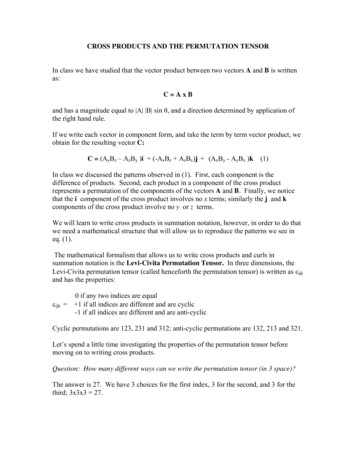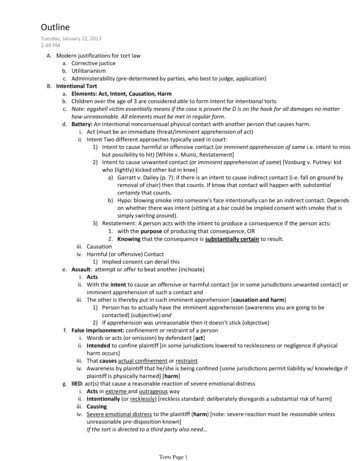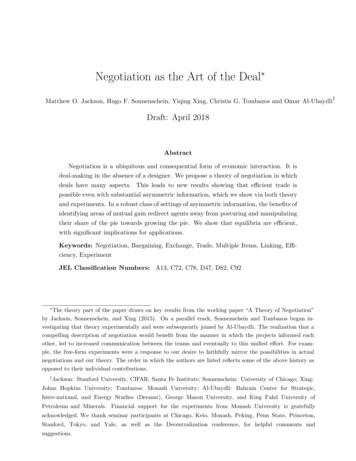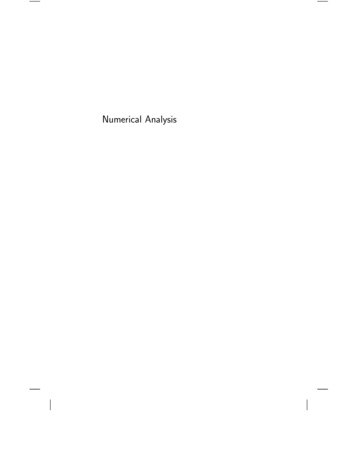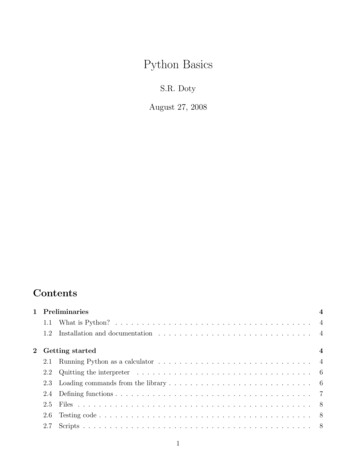
Transcription
Python BasicsS.R. DotyAugust 27, 2008Contents1 Preliminaries41.1 What is Python? . . . . . . . . . . . . . . . . . . . . . . . . . . . . . . . . . . . . .41.2 Installation and documentation . . . . . . . . . . . . . . . . . . . . . . . . . . . . .42 Getting started42.1 Running Python as a calculator . . . . . . . . . . . . . . . . . . . . . . . . . . . . .42.2 Quitting the interpreter. . . . . . . . . . . . . . . . . . . . . . . . . . . . . . . . .62.3 Loading commands from the library . . . . . . . . . . . . . . . . . . . . . . . . . . .62.4 Defining functions . . . . . . . . . . . . . . . . . . . . . . . . . . . . . . . . . . . . .72.5 Files . . . . . . . . . . . . . . . . . . . . . . . . . . . . . . . . . . . . . . . . . . . .82.6 Testing code . . . . . . . . . . . . . . . . . . . . . . . . . . . . . . . . . . . . . . . .82.7 Scripts . . . . . . . . . . . . . . . . . . . . . . . . . . . . . . . . . . . . . . . . . . .81
3 Python commands93.1 Comments . . . . . . . . . . . . . . . . . . . . . . . . . . . . . . . . . . . . . . . . .93.2 Numbers and other data types . . . . . . . . . . . . . . . . . . . . . . . . . . . . . .93.2.1The type function . . . . . . . . . . . . . . . . . . . . . . . . . . . . . . . .93.2.2Strings . . . . . . . . . . . . . . . . . . . . . . . . . . . . . . . . . . . . . . . 103.2.3Lists and tuples . . . . . . . . . . . . . . . . . . . . . . . . . . . . . . . . . . 103.2.4The range function . . . . . . . . . . . . . . . . . . . . . . . . . . . . . . . . 113.2.5Boolean values . . . . . . . . . . . . . . . . . . . . . . . . . . . . . . . . . . 113.3 Expressions . . . . . . . . . . . . . . . . . . . . . . . . . . . . . . . . . . . . . . . . 113.4 Operators . . . . . . . . . . . . . . . . . . . . . . . . . . . . . . . . . . . . . . . . . 113.5 Variables and assignment . . . . . . . . . . . . . . . . . . . . . . . . . . . . . . . . . 133.6 Decisions . . . . . . . . . . . . . . . . . . . . . . . . . . . . . . . . . . . . . . . . . . 133.7 Loops . . . . . . . . . . . . . . . . . . . . . . . . . . . . . . . . . . . . . . . . . . . 143.7.1for loop . . . . . . . . . . . . . . . . . . . . . . . . . . . . . . . . . . . . . . 143.7.2while loop . . . . . . . . . . . . . . . . . . . . . . . . . . . . . . . . . . . . . 153.7.3else in loops . . . . . . . . . . . . . . . . . . . . . . . . . . . . . . . . . . . 153.7.4break, continue, and pass . . . . . . . . . . . . . . . . . . . . . . . . . . . 163.8 Lists . . . . . . . . . . . . . . . . . . . . . . . . . . . . . . . . . . . . . . . . . . . . 163.8.1Length of a list; empty list . . . . . . . . . . . . . . . . . . . . . . . . . . . . 173.8.2Sublists (slicing) . . . . . . . . . . . . . . . . . . . . . . . . . . . . . . . . . 173.8.3Joining two lists . . . . . . . . . . . . . . . . . . . . . . . . . . . . . . . . . . 183.8.4List methods . . . . . . . . . . . . . . . . . . . . . . . . . . . . . . . . . . . 183.9 Strings . . . . . . . . . . . . . . . . . . . . . . . . . . . . . . . . . . . . . . . . . . . 192
http://www.xkcd.com/353/3
1Preliminaries1.1What is Python?Python is a powerful modern computer programming language. It bears some similarities toFortran, one of the earliest programming languages, but it is much more powerful than Fortran.Python allows you to use variables without declaring them (i.e., it determines types implicitly),and it relies on indentation as a control structure. You are not forced to define classes in Python(unlike Java) but you are free to do so when convenient.Python was developed by Guido van Rossum, and it is free software. Free as in “free beer,” in thatyou can obtain Python without spending any money. But Python is also free in other importantways, for example you are free to copy it as many times as you like, and free to study the sourcecode, and make changes to it. There is a worldwide movement behind the idea of free software,initiated in 1983 by Richard Stallman.1This document focuses on learning Python for the purpose of doing mathematical calculations.We assume the reader has some knowledge of basic mathematics, but we try not to assume anyprevious exposure to computer programming, although some such exposure would certainly behelpful. Python is a good choice for mathematical calculations, since we can write code quickly, testit easily, and its syntax is similar to the way mathematical ideas are expressed in the mathematicalliterature. By learning Python you will also be learning a major tool used by many web developers.1.2Installation and documentationIf you use Mac OS X or Linux, then Python should already be installed on your computer bydefault. If not, you can download the latest version by visiting the Python home page, athttp://www.python.orgwhere you will also find loads of documentation and other useful information. Windows users canalso download Python at this website. Don’t forget this website; it is your first point of referencefor all things Python. You will find there, for example, reference [1], the excellent Python Tutorialby Guido van Rossum. You may find it useful to read along in the Tutorial as a supplement tothis document.2Getting started2.1Running Python as a calculatorThe easiest way to get started is to run Python as an interpreter, which behaves similar to theway one would use a calculator. In the interpreter, you type a command, and Python producesthe answer. Then you type another command, which again produes an answer, and so on.In OS X or Linux, to start the Python interpreter is as simple as typing the command pythonon the command line in a terminal shell. In Windows, assuming that Python has already been1See http://www.fsf.org or http://www.opensource.org for more information.4
installed, you need to find Python in the appropriate menu. Windows users may choose to runPython in a command shell (i.e., a DOS window) where it will behave very similarly to Linux orOS X.For all three operating systems (Linux, OS X, Windows) there is also an integrated developmentenvironment for Python named IDLE. If interested, you may download and install this on your computer.2 For help on getting started with IDLE see http://hkn.eecs.berkeley.edu/ dyoo/python/idle intOnce Python starts running in interpreter mode, using IDLE or a command shell, it produces aprompt, which waits for your input. For example, this is what I get when I start Python in acommand shell on my Linux box:d o t y @ b r a u e r : % pythonPython 2.5.2 ( r252 :60911 , Apr 21 2008 , 1 1 : 1 2 : 4 2 )[ GCC 4.2.3 ( Ubuntu 4.2.3 -2 u b u n t u 7 )] on linux2Type " help " , " c o p y r i g h t" , " c r e d i t s" or " l i c e n s e" for moreinformation. where the three symbols indicates the prompt awaiting my input.So experiment, using the Python interpreter as a calculator. Be assured that you cannot harmanything, so play with Python as much as you like. For example: 2*10242048 3 4 916 2**1001267650600228229401496703205376 LIn the above, we first asked for the product of 2 and 1024, then we asked for the sum of 3, 4, and 9and finally we asked for the value of 2100 . Note that multiplication in Python is represented by ,addition by , and exponents by **; you will need to remember this syntax. The L appended tothe last answer is there to indicate that this is a long integer; more on this later. It is also worthnoting that Python does arbitrary precision integer arithmetic, by default: 2 * * 1 0 0 4182153046474983581941267398767559165543946077 0 6 2 9 1 4 5 7 1 1 9 6 4 7 7 6 8 6 5 4 2 1 6 7 6 6 0 4 2 9 8 3 1 6 5 2 6 2 4 3 8 6 8 3 7 2 0 5 6 6 8 0 6 9 3 7 6LHere is another example, where we print a table of perfect squares: for n in [1 ,2 ,3 ,4 ,5 ,6]:.print n **2.1491625362Both Python and IDLE should be already preinstalled on all Loyola Windows computers.5
This illustrates several points. First, the expression [1,2,3,4,5,6] is a list, and we print the valuesof n2 for n varying over the list. If we prefer, we can print horizontally instead of vertically: for n in [1 ,2 ,3 ,4 ,5 ,6]:.print n **2 ,.1 4 9 16 25 36simply by adding a comma at the end of the print command, which tells Python not to move toa new line before the next print.These last two examples are examples of a compound command, where the command is dividedover two lines (or more). That is why you see . on the second line instead of the usual ,which is the interpreter’s way of telling us it awaits the rest of the command. On the third linewe entered nothing, in order to tell the interpreter that the command was complete at the secondline. Also notice the colon at the end of the first line, and the indentation in the second line. Bothare required in compound Python commands.2.2Quitting the interpreterIn a terminal you can quit a Python session by CTRL-D. (Hold down the CTRL key while pressingthe D key.) In IDLE you can also quit from the menu.If the interpreter gets stuck in an infinite loop, you can quit the current execution by CTRL-C.2.3Loading commands from the libraryPython has a very extensive library of commands, documented in the Python Library ReferenceManual [2]. These commands are organized into modules. One of the available modules is especiallyuseful for us: the math module. Let’s see how it may be used. from math import sqrt , exp exp ( -1)0.36787944117144233 sqrt (2)1.4142135623730951We first import the sqrt and exp functions from the math module, then use them to compute 1e 1/e and 2.Once we have loaded a function from a module, it is available for the rest of that session. Whenwe start a new session, we have to reload the function if we need it.Note that we could have loaded both functions sqrt and exp by using a wildcard *: from math import *which tells Python to import all the functions in the math module.What would have happened if we forgot to import a needed function? After starting a new session,if we type sqrt (2)T r a c e b a c k ( most recent call last ):File " stdin " , line 1 , in module N a m e E r r o r : name ’ sqrt ’ is not d e f i n e d6
we see an example of an error message, telling us that Python does not recognize sqrt.2.4Defining functionsIt is possible, and very useful, to define our own functions in Python. Generally speaking, if youneed to do a calculation only once, then use the interpreter. But when you or others have need toperform a certain type of calculation many times, then define a function. For a simple example,the compound command def f ( x ):.return x * x.defines the squaring function f (x) x2 , a popular example used in elementary math courses. Inthe definition, the first line is the function header where the name, f, of the function is specified.Subsequent lines give the body of the function, where the output value is calculated. Note thatthe final step is to return the answer; without it we would never see any results. Continuing theexample, we can use the function to calculate the square of any given input: f (2)4 f (2.5)6.25The name of a function is purely arbitrary. We could have defined the same function as above,but with the name square instead of f; then to use it we use the new function name instead ofthe old: def square ( x ):.return x * x. square (3)9 square (2.5)6.25Actually, a function name is not completely arbitrary, since we are not allowed to use a reservedword as a function name. Python’s reserved words are: and, def, del, for, is, raise, assert,elif, from, lambda, return, break, else, global, not, try, class, except, if, or, while,continue, exec, import, pass, yield.By the way, Python also allows us to define functions using a format similar to the LambdaCalculus in mathematical logic. For instance, the above function could alternatively be defined inthe following way: square lambda x : x * xHere lambda x: x*x is known as a lambda expression. Lambda expressions are useful when youneed to define a function in just one line; they are also useful in situations where you need afunction but don’t want to name it.Usually function definitions will be stored in a module (file) for later use. These are indistinguishable from Python’s Library modules from the user’s perspective.7
2.5FilesPython allows us to store our code in files (also called modules). This is very useful for moreserious programming, where we do not want to retype a long function definition from the verybeginning just to change one mistake. In doing this, we are essentially defining our own modules,just like the modules defined already in the Python library. For example, to store our squaringfunction example in a file, we can use any text editor3 to type the code into a file, such asdef square ( x ):return x * xNotice that we omit the prompt symbols , . when typing the code into a file, but theindentation is still important. Let’s save this file under the name “SquaringFunction.py” and thenopen a terminal in order to run it:d o t y @ b r a u e r : % pythonPython 2.5.2 ( r252 :60911 , Apr 21 2008 , 1 1 : 1 2 : 4 2 )[ GCC 4.2.3 ( Ubuntu 4.2.3 -2 u b u n t u 7 )] on linux2Type " help " , " c o p y r i g h t" , " c r e d i t s" or " l i c e n s e"for more i n f o r m a t i o n . from S q u a r i n g F u n c t i o n import square square (1.5)2.25Notice that I had to import the function from the file before I could use it. Importing a commandfrom a file works exactly the same as for library modules. (In fact, some people refer to Pythonfiles as “modules” because of this analogy.) Also notice that the file’s extension (.py) is omittedin the import command.2.6Testing codeAs indicated above, code is usually developed in a file using an editor. To test the code, import itinto a Python session and try to run it. Usually there is an error, so you go back to the file, makea correction, and test again. This process is repeated until you are satisfied that the code works.The entire process is known as the development cycle.There are two types of errors that you will encounter. Syntax errors occur when the form ofsome command is invalid. This happens when you make typing errors such as misspellings, orcall something by the wrong name, and for many other reasons. Python will always give an errormessage for a syntax error.2.7ScriptsIf you use Mac OS X or some other variant of Unix (such as Linux) then you may be interestedin running Python commands as a script. Here’s an example. Use an editor to create a file nameSayHi containing the following lines# ! / usr / bin / pythonprint " Hello World ! "print " - From your f r i e n d l y Python p r o g r a m"3Most developers rely on emacs for editing code. Other possible choices are Notepad for Windows, gedit forLinux/Gnome, and TextEdit for OS X. IDLE comes with its own editor, by the way.8
The first line tells Python that this is a script. After saving the file, make it executable by typingchmod 755 SayHi in the terminal. To run the script, type ./SayHi in the terminal. Note that ifyou move the script someplace in your search path, then you can run it simply by typing SayHi.Type echo PATH to see what folders are in your search path, and type which python to see whereyour python program is — this should match the first line in your script.As far as I know, it is impossible to run Python scripts in a similar way on a Windows machine.33.1Python commandsCommentsIn a Python command, anything after a # symbol is a comment. For example:print " Hello world " # this is sillyComments are not part of the command, but rather intended as documentation for anyone readingthe code.Multiline comments are also possible, and are enclosed by triple double-quote symbols:" " " This is an e x a m p l e of a long c o m m e n tthat goes onand onand on . " " "3.2Numbers and other data typesPython recognizes several different types of data. For instance, 23 and 75 are integers, while 5.0and 23.09 are floats or floating point numbers. The type float is (roughly) the same as a realnumber in mathematics. The number 12345678901 is a long integer ; Python prints it with an “L”appended to the end.Usually the type of a piece of data is determined implicitly.3.2.1The type functionTo see the type of some data, use Python’s builtin type function: type ( -75) type ’ int ’ type (5.0) type ’ float ’ type ( 1 2 3 4 5 6 7 8 9 0 1 ) type ’ long ’ Another useful data type is complex, used for complex numbers. For example: 2 j2j 2j -1( -1 2 j ) c o m p l e x (2 ,3)9
(2 3 j ) type ( -1 2 j ) type ’ c o m p l e x ’ Notice that Python uses j for the complex unit (such that j 2 1) just as physicists do, insteadof the letter i preferred by mathematicians.3.2.2StringsOther useful data types are strings (short for “character strings”); for example "Hello World!".Strings are sequences of characters enclosed in single or double quotes: " This is a string "’ This is a string ’ ’ This is a string , too ’’ This is a string , too ’ type ( " This is a string " ) type ’ str ’ Strings are an example of a sequence type.3.2.3Lists and tuplesOther important sequence types used in Python include lists and tuples. A sequence type is formedby putting together some other types in a sequence. Here is how we form lists and tuples: [1 ,3 ,4 ,1 ,6][1 , 3 , 4 , 1 , 6] type ( [1 ,3 ,4 ,1 ,6] ) type ’ list ’ (1 ,3 ,2)(1 , 3 , 2) type ( (1 ,3 ,2) ) type ’ tuple ’ Notice that lists are enclosed in square brackets while tuples are enclosed in parentheses. Also notethat lists and tuples do not need to be homogeneous; that is, the components can be of differenttypes: [1 ,2 , " Hello " ,(1 ,2)][1 , 2 , ’ Hello ’ , (1 , 2)]Here we created a list containing four components: two integers, a string, and a tuple. Note thatcomponents of lists may be other lists, and so on: [1 , 2 , [1 ,2] , [1 ,[1 ,2]] , 5][1 , 2 , [1 , 2] , [1 , [1 , 2]] , 5]By nesting lists within lists in this way, we can build up complicated stuctures.Sequence types such as lists, tuples, and strings are always ordered, as opposed to a set in mathematics, which is always unordered. Also, repetition is allowed in a sequence, but not in a set.10
3.2.4The range functionThe range function is often used to create lists of integers. It has three forms. In the simplestform, range(n) produces a list of all numbers 0, 1, 2, . . . , n 1 starting with 0 and ending withn 1. For instance, range (17)[0 , 1 , 2 , 3 , 4 , 5 , 6 , 7 , 8 , 9 , 10 , 11 , 12 , 13 , 14 , 15 , 16]You can also specify an optional starting point and an increment, which may be negative. Forinstance, we have range (1 ,10)[1 , 2 , 3 , 4 , 5 , 6 , 7 , 8 , 9] range ( -6 ,0)[ -6 , -5 , -4 , -3 , -2 , -1] range (1 ,10 ,2)[1 , 3 , 5 , 7 , 9] range (10 ,0 , -2)[10 , 8 , 6 , 4 , 2]Note the use of a negative increment in the last example.3.2.5Boolean valuesFinally, we should mention the boolean type. This is a value which is either True or False. TrueTrue type ( True ) type ’ bool ’ FalseFalse type ( False ) type ’ bool ’ Boolean types are used in making decisions.3.3ExpressionsPython expressions are not commands, but rather form part of a command. An expression isanything which produces a value. Examples of expressions are: 2 2, 2**100, f((x-1)/(x 1)).Note that in order for Python to make sense of the last one, the variable x must have a valueassigned and f should be a previously defined function.Expressions are formed from variables, constants, function evaluations, and operators. Parenthesesare used to indicate order of operations and grouping, as usual.3.4OperatorsThe common binary operators for arithmetic are for addition, - for subtraction, * for multiplication, and / for division. As already mentioned, Python uses ** for exponentiation. Integerdivision is performed so that the result is always another integer (the integer quotient):11
25/38 5/22This is a wrinkle that you will always have to keep in mind when working with Python. To get amore accurate answer, use the float type: 25.0/38.3333333333333339 5/2.02.5If just one of the operands is of type float, then the result will be of type float. Here is anotherexample of this pitfall: 2 * * ( 1 / 2 )1where we wanted to compute the square root of 2 as the 12 power of 2, but the division in theexponent produced a result of 0 because of integer division. A correct way to do this computationis: 2**0.51.4142135623730951Another useful operator is %, which is read as ”mod”. This gives the remainder of an integerdivision, as in 5 % 21 25 % 31which shows that 5 mod 2 1, and 25 mod 3 1. This operator is useful in number theory andcryptography.Besides the arithmetic operators we need comparison operators: , , , , , ! , . In orderthese are read as: is less than, is greater than, is less than or equal to, is greater than or equal to,is equal to, is not equal to, is not equal to. The result of a comparison is always a boolen valueTrue or False. 2 3True 3 2False 3 2FalseNote that ! and are synonomous; either one means not equal to. Also, the operator meansis equal to. 2 3True 2 ! 3True 0 ! 0False12
0 0True3.5Variables and assignmentAn assignment statement in Python has the form variable expression. This has the followingeffect. First the expression on the right hand side is evaluated, then the result is assigned to thevariable. After the assignment, the variable becomes a name for the result. The variable retainsthe same value until another value is assigned, in which case the previous value is lost. Executingthe assignment produces no output; its purpose it to make the association between the variableand its value. x 2 2 print x4In the example above, the assignment statement sets x to 4, producing no output. If we want tosee the value of x, we must print it. If we execute another assignment to x, then the previous valueis lost. x 380.5 print x380.5 y 2* x print y761.0Remember: A single is used for assignment, the double is used to test for equality.In mathematics the equation x x 1 is nonsense; it has no solution. In computer science, thestatement x x 1 is useful. Its purpose is to add 1 to x, and reassign the result to x. In short,x is incremented by 1. 11 12x 10x x 1print xx x 1print xVariable names may be any contiguous sequence of letters, numbers, and the underscore ( ) character. The first character must not be a number, and you may not use a reserved word as a variablename. Case is important; for instance Sum is a different name than sum. Other examples of legalvariable names are: a, v1, v 1, abc, Bucket, monthly total, pi , TotalAssets.3.6DecisionsThe if–else is used to make choices in Python code. This is a compound statement. The simplestform isif c o n d i t i o n :a c t i o n 113
else :a c t i o n 2The indentation is required. Note that the else and its action are optional. The actions action-1and action-2 may consist of many statements; they must all be indented the same amount. Thecondition is an expression which evaluates to True or False.Of course, if the condition evaluates to True then action-1 is executed, otherwise action-2 is executed. In either case execution continues with the statement after the if-else. For example, thecodex 1if x 0:print " Friday is w o n d e r f u l"else :print " Monday sucks "print " Have a good w e e k e n d"results in the outputFriday is w o n d e r f u lHave a good w e e k e n dNote that the last print statement is not part of the if-else statement (because it isn’t indented),so if we change the first line to say x 0 then the output would beMonday sucksHave a good w e e k e n dMore complex decisions may have several alternatives depending on several conditions. For thesethe elif is used. It means “else if” and one can have any number of elif clauses between the ifand the else. The usage of elif is best illustrated by an example:if x 0 and x 10:digits 1elif x 10 and x 100:digits 2elif x 100 and x 1000:digits 3elif x 1000 and x 10000:digits 4else :digits 0 # more than 4In the above, the number of digits in x is computed, so long as the number is 4 or less. If x isnegative or greater than 10000, then digits will be set to zero.3.7LoopsPython provides two looping commands: for and while. These are compound commands.3.7.1for loopThe syntax of a for loop is14
for i t e m in l i s t :actionAs usual, the action consists of one or more statements, all at the same indentation level. Thesestatements are also known as the body of the loop. The item is a variable name, and list is a list.Execution of the for loop works by setting the variable successively to each item in the list, andthen executing the body each time. Here is a simple example (the comma at the end of the printmakes all printing occur on the same line):for i in [2 , 4 , 6 , 0]:print i ,This produces the output2 4 6 03.7.2while loopThe syntax of the while loop iswhile c o n d i t i o n :actionOf course, the action may consist of one or more statements all at the same indentation level. Thestatements in the action are known as the body of the loop. Execution of the loop works as follows.First the condition is evaluated. If True, the body is executed and the condition evaluated again,and this repeats until the condition evaluates to False. Here is a simple example:n 0while n 10:print n ,n n 3This produces the following output0 3 6 9Note that the body of a while loop is never executed if the condition evaluates to False the firsttime. Also, if the body does not change the subsequent evaluations of the condition, an infiniteloop may occur. For examplewhile True :print " Hello " ,will print Hellos endlessly. To interrupt the execution of an infinite loop, use CTRL-C.3.7.3else in loopsA loop may have an optional else which is executed when the loop finishes. For example, theloopfor n in [10 ,9 ,8 ,7 ,6 ,5 ,4 ,3 ,2 ,1]:print n ,else :print " b l a s t o f f"15
results in the output10 9 8 7 6 5 4 3 2 1 b l a s t o f fand the loopn 10while nprintn nelse :print 0:n,- 1" b l a s t o f f"has the same effect (it produces identical output).3.7.4break, continue, and passThe break statement, like in C, breaks out of the smallest enclosing for or while loop. Thecontinue statement, also borrowed from C, continues with the next iteration of the loop. Thepass statement does nothing. It can be used when a statement is required syntactically but theprogram requires no action.Here is an example of the use of a break statement and an else clause in a loop.for n in range (2 , 10):for x in range (2 , n ):if n % x 0:print n , ’ equals ’ , x , ’* ’ , n / xbreakelse :# loop fell t h r o u g h w i t h o u t f i n d i n g a factorprint n , ’ is a prime number ’The above code searches for prime numbers between 2 and 10, and produces the following output.23456789is a primeis a primeequals 2 *is a primeequals 2 *is a primeequals 2 *equals 3 *3.8numbernumber2number3number43ListsAs already mentioned, a list is a finite sequence of items, and one could use the range function tocreate lists of integers.In Python, lists are not required to be homogeneous, i.e., the items could be of different types.For example,a [2 , " Jack " , 45 , " 23 W e n t w o r t h Ave " ]is a perfectly valid list consisting of two integers and two strings. One can refer to the entire listusing the identifier a or to the i-th item in the list using a[i].16
a [2 , " Jack " , 45 , " 23 W e n t w o r t h Ave " ] a[2 , ’ Jack ’ , 45 , ’ 23 W e n t w o r t h Ave ’] a [0]2 a [1]’ Jack ’ a [2]45 a [3]’ 23 W e n t w o r t h Ave ’Note that the numbering of list items always begins at 0 in Python. So the four items in the abovelist are indexed by the numbers 0, 1, 2, 3.List items may be assigned a new value; this of course changes the list. For example, with a asabove: a[2 , ’ Jack ’ , 45 , ’ 23 W e n t w o r t h Ave ’] a [0] 2002 a[2002 , ’ Jack ’ , 45 , ’ 23 W e n t w o r t h Ave ’]Of course, the entire list may be assigned a new value, which does not have to be a list. Whenthis happens, the previous value is lost: a[2002 , ’ Jack ’ , 45 , ’ 23 W e n t w o r t h Ave ’] a ’ g o b b l e t y g o o k ’ a’ gobbletygook’3.8.1Length of a list; empty listEvery list has a length, the number of items in the list, obtained using the len function: x [9 , 4 , 900 , -45] len ( x )4Of special importance is the empty list of length 0. This is created as follows: x [] len ( x )03.8.2Sublists (slicing)Sublists are obtained by slicing, which works analogously to the range function discussed before.If x is an existing list, then x[start:end] is the sublist consisting of all items in the original listat index positions i such thatstart i end.Of course, we must remember that indexing items always starts at 0 in Python. For example,17
[0 , [4 , [0 ,x range (0 ,20 ,2)x2 , 4 , 6 , 8 , 10 , 12 , 14 , 16 , 18]x [2:5]6 , 8]x [0:5]2 , 4 , 6 , 8]When taking a slice, either parameter start or end may be omitted: if start is omitted then theslice consists of all items up to, but not including, the one at index position end, similarly, if endis omitted the slice consists of all items starting with the one at position start. For instance, withthe list x as defined above we have [0 , [4 ,x [:5]2 , 4 , 6 , 8]x [2:]6 , 8 , 10 , 12 , 14 , 16 , 18]In this case, x[:5] is equivalent to x[0:5] and x[2:] is equivalent to x[2:len(x)].There is an optional third parameter in a slice, which if present represents an increment, just asin the range function. For example, [0 , [0 , [0 ,list range (20)list1 ,
helpful. Python is a good choice for mathematical calculations, since we can write code quickly, test it easily, and its syntax is similar to the way mathematical ideas are expressed in the mathematical literature. By learning Python you will also be learning a major tool used b
